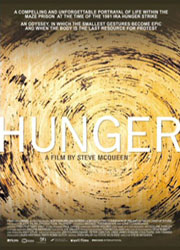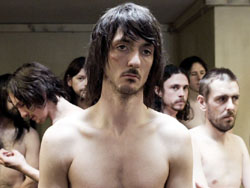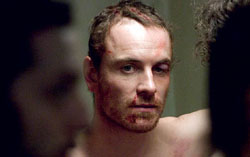“I could take the punishment for all our boys; I had the respect of them other boys now, and I knew it.”
Going into Hunger, I didn’t know much about The Troubles. In fact, I still don’t know much about that time in Northern Ireland. Should you choose to jump right into the film without doing a little reading on The Troubles, you won’t either.  That seems to be one of the things Enda Walsh and Steve McQueen intended on doing. There is no back story, or hints of the character’s past. You, as the viewer, are dropped right in the middle of an ongoing struggle between prison guard, and protesting prisoner. In order to fully appreciate what is happening on screen, I believe that one must have a bit of history about the events leading up to where Hunger starts.
That seems to be one of the things Enda Walsh and Steve McQueen intended on doing. There is no back story, or hints of the character’s past. You, as the viewer, are dropped right in the middle of an ongoing struggle between prison guard, and protesting prisoner. In order to fully appreciate what is happening on screen, I believe that one must have a bit of history about the events leading up to where Hunger starts.
In 1976, as a result of the British Government stripping political status for paramilitary prisoners, a ‘blanket protest’ was started. This was the act of inmates refusing to wear standard prisoner uniforms thus wrapping themselves in their blankets. Early in the year, the IRA started targeting prison officers. This led to the death of nineteen men over five years which brought about guard retaliation on inmates inside the walls of the prisons. After suffering from attacks by prison guards while attempting to ‘slop out’ or empty their chamber pots, the inmates started smearing their feces on the walls of their cells, and using their meals to construct funnels at the base of their cell doors in order to release collected urine out into the hallways. These protests continued for five years, culminating the 1981 Irish Hunger Strikes. Hunger takes place before the beginning of these strikes.
For the first six minutes of the film, McQueen elects to use no dialog, allowing the viewer to simply watch what is happening on screen. It isn’t until after these events that the first line is heard from one of the on screen actors. Outside of the middle act, dialog is very sparse. It feels as if McQueen’s intentions were to draw the viewer’s full attention to the visuals and the sounds of the harsh living conditions these men, both prisoner and guard, find themselves in.

Prison Guard Raymond (Stewart Graham) plays a pivotal role in the beginning third of the film as his fear and anger on the outside world fuel is cruelty on the inside of the H-Blocks of Her Majesty’s Prison Maze. He is the first character met, followed by his wife as she holds her breath in anticipation of her husband’s car exploding upon ignition. We follow Raymond to work, through the door for employees and into the locker room where the guards are changing for duty. There are bit shots of Raymond early on in the film as his day goes on, getting more and more worn down until, drenched in what appears to be sweat, takes a smoke break to calm his nerves and allow his bloodied knuckles a chance to throb in peace. Raymond’s last appearance in Hunger reinforces the notion that violence begets violence in a very literal, brutal scene.
McQueen goes through great lengths to show the horrid conditions these men chose to live in, and the violence extolled upon them by the guards. He is not a director, or at least he wasn’t while making this film. He was however, a photographer and a painter. He knows how to frame a shot beautifully, even in the ugliest of sets used throughout Hunger. Every shot is framed like a still photograph that has motion opposed to a motion picture with photographic angles. This skill of his is on full display during this twenty three minute scene between Bobby (Michael Fassbender) and Father Dominic Moran (Liam Cunningham.) What transpires is this wonderful, single shot view of the two men  as they argue over the use of a hunger strike. McQueen has stated that he went with a single shot as he wanted the viewer to feel like they were in the room watching it unfold as opposed to being an active participant. It worked marvelously. This is just one example, as the film is filled with these wonderful shots.
as they argue over the use of a hunger strike. McQueen has stated that he went with a single shot as he wanted the viewer to feel like they were in the room watching it unfold as opposed to being an active participant. It worked marvelously. This is just one example, as the film is filled with these wonderful shots.
From here, the final act begins. Bobby starts his hunger strike and we rejoin him a few weeks into his fight. If one didn’t appreciate what Fassbender brings to the table before this movie, there is no way to continue with that thought after. In Christian Bale's performance in The Machinist fashion, he starved himself to better portray the withering Bobby in his final moments. Watching his frail frame slowly moving with the help of medical staff, or just laying in bed hardly moving with huge bed sores and protruding bones, his face sunken and distorted with hardly enough energy to continue his struggle to breathe is just as difficult to sit through as everything else that’s been thrown at the viewer before hand. As a matter of fact, McQueen is able to get the most out of his actors. They hold nothing back as they are beaten, stripped naked, thrown around and put into some seriously degrading situations.
Hunger is disgusting and horrifically ugly, but its ugliness is controlled, focused and self serving. The ugliness is used to paint the picture of the horrors the inmates lived, though a lot was self served, and the lengths they went through to get their demands met. Hunger deserves to be seen by everyone who has an appreciation for cinema. This is Steve McQueen’s debut, and if it’s any indication of things to come, he will be a force one should not ignore. His willingness to push the boundaries of modern sensibilities is a welcome change.
Please feel free to discuss "Hunger" here, in our forums!

